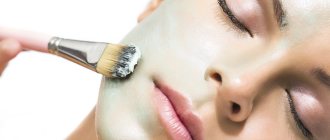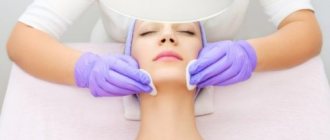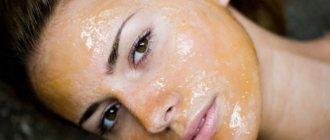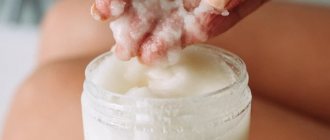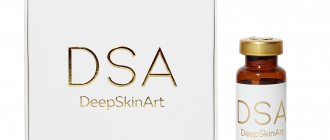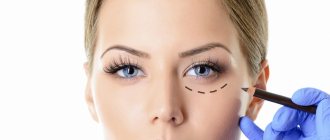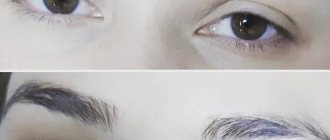- Buy the best post-peeling cream
- Who needs peeling and why?
- Skin after peeling
- Myths about post-peeling care
- Rules of care before and after peeling
- The best post-peeling cream: a review of products with active ingredients
Peeling is a procedure of exfoliation, that is, exfoliation of the skin .
You can do it in a salon from a professional cosmetologist, buy an acid peel, or even do an exfoliating procedure at home using improvised means.
But the result is not always pleasant: the skin turns red, itches, flakes, and rashes appear . Why is this happening? How to avoid negative consequences?
We find out what you can and cannot do before and after peeling, and also understand the intricacies of skin care. Review of the best products for restoring skin after peeling.
Why do you need additional care after peeling?
Peeling is carried out at superficial, medium and deep levels. For this purpose, various drugs and means are used. It could be just scrubs or chemical acids. After exposure to aggressive cleansing substances, the skin receives microtrauma. The recovery period can last from one day to several months, depending on the type of peeling. Temporarily, the skin will develop marks similar to burns.
This condition, as well as severe peeling, is a normal and even obligatory consequence after peeling. But if no measures are taken, this situation can continue for quite a long time. Therefore, in order to reduce rehabilitation time and avoid side effects, masks, gels, and creams should be used.
According to the recommendations of cosmetologists, after peeling you need products with anti-inflammatory, antibacterial, protective and moisturizing properties.
The following types of procedures will help cope with the consequences of peeling:
- Masks for hydration and regeneration. These are special species and are not used for permanent care.
- Soothing to relieve irritation and redness after peeling.
Home care after the procedure has its own characteristics:
- After medium peeling, you should not touch your facial skin for 3-4 days, and the use of decorative cosmetics is also prohibited.
- If it is deep, recovery will take about 30 days. It is extremely important to protect your face from exposure to ultraviolet rays.
- Superficial peeling is the least traumatic; the skin will need a maximum of a day to recover.
- You can return to your usual daily care no earlier than after a week.
- For a month or two you cannot go to baths, saunas, or swimming pools.
- If itching or swelling occurs, you should use soothing, anti-inflammatory masks and gels.
If you build the right care program, it will take much less time for rehabilitation, and the result of the procedure will become more effective.
We recommend reading about chemical peels for the face. From the article you will learn about indications and contraindications for the procedure, chemical peeling preparations, methods of implementation, and results. And here is more information about the rules of facial care after chemical peeling.
What is coconut oil
One of the favorite souvenirs from hot Asian countries is coconut oil. It is obtained from the so-called copra (oily pulp of coconuts) by cold or hot pressing. The first, as you understand, is much more valuable, since it allows you to preserve the maximum amount of useful substances in the oil. And there are a lot of them in it.
Coconut oil is used not only in cooking, but also in beauty. © Getty Images
Externally, coconut oil is somewhat different from other vegetable oils in color and texture that changes depending on the temperature of the environment. If the temperature on the thermometer is more than 25 °C, it is liquid and almost transparent, and at lower temperatures the oil turns into a thick white mass, similar in consistency to wax.
The scope of application of coconut oil is quite extensive. It is used as:
ingredient in masks for weak and damaged hair;
a product that smoothes wrinkles and softens the skin;
a means for losing weight (which is very controversial).
Compound
Why is coconut oil so valued? Not only for its subtle sweet aroma, but also for its unique composition. What is so valuable about it?
Complex of unsaturated fatty acids. Their composition is similar to the lipids of our skin, and this allows the oil to effectively restore the hydrolipidic film, promoting softness and smoothness of the skin.
Vitamin E is a well-known and quite strong antioxidant that fights oxidation processes that accelerate the aging process, and at the same time nourishes the skin.
But this useful set also has a fly in the ointment: coconut oil is quite high in saturated fat. They are responsible for increasing cholesterol levels and gaining excess weight. In addition, there is an opinion that coconut oil can be a rather serious allergen.
Should I make face masks?
The procedures after peeling should be selected by the cosmetologist who performed it. Maintenance should be done according to the type of cleaning. So, in one case it will take only a few days, in another - a couple of weeks. But in any case, during this period you need to be more attentive to your skin.
After chemical peeling
The deep type of cleansing involves the almost complete dissolution of the surface layer of the epidermis. The result is very similar to a third degree burn. He's just as strong. The upper layer of the dermis after deep chemical peeling becomes one continuous wound.
The recovery period is very difficult and painful, it can take up to six months. However, the result exceeds all expectations. After rehabilitation, the skin becomes fresh, radiant, elastic and firm. Deep peeling helps get rid of wrinkles, even very serious ones. Old scars and age spots also disappear. After this procedure it is possible to look several years younger. Typically, the recovery period is divided into four stages:
- During the first twelve hours, the skin should not be touched at all. There is no need to try to use any means.
- At the second stage, you need to make compresses and lotions from slightly acidic solutions. In addition, the surface of the skin should be treated with ointments with soothing properties or Vaseline. The cosmetologist who performed the deep peeling prescribes a special moisturizer. It must be applied to the entire surface carefully, without injuring the skin, or you can make compresses and applications.
You cannot look for this remedy on your own; it should only be prescribed by a specialist who sees the picture and the individual reaction.
- On the third day and over the next two weeks, you need to go to a special dressing - occlusive. This means applying a cream that helps the formation of a new healthy layer of epithelium, without scars or side effects.
- The final stage lasts until the normal dermis is completely restored. Each person is different. All this time, ointments and other products that have regenerating properties should be used. It is also important to constantly use a cream with a high SPF factor.
At the end of the recovery stage, you can make tonic and moisturizing masks from sour cream, honey, yogurt, fatty oils, and oatmeal.
After superficial
Fruit acids do not damage the dermis as much, so care is not so difficult. With superficial peeling, substances are applied to the skin that can only dissolve the epidermis. During the procedure, tissues deeper than the dermis or basement membrane are not affected. Peeling is carried out with lactic, fruit, retinoic, salicylic, glycolic acids or enzymes. As a result, a skin burn occurs, caused by a cosmetologist.
Since the impact is not very strong, it is important to follow some rules after exfoliation:
- The skin needs to be cleansed carefully and delicately.
- It needs constant hydration.
- It is important to choose products with a high degree of protection from external factors.
As a rule, the maximum recovery time does not exceed a month. During the first 5 - 7 days, there is severe peeling of dead cells as a result of peeling. At this time, do not use aggressive cleansers. In addition, it is necessary to use a cream with a high sun protection factor. Otherwise, age spots may appear, which will be much more difficult to remove.
However, you should not use such products yourself, since only a cosmetologist who performed facial cleansing can prescribe any cosmetic or therapeutic ointments, creams or sprays.
A few days later, as soon as the doctor allows, you can make soothing masks with herbs, moisturizing masks with honey, sour cream and fatty oils.
With proper and competent post-peeling care, you can enjoy the result for a long time without experiencing any side complications.
After the middle
This type of exfoliation involves exposure no deeper than the surface layer of the epidermis. But the burn after the procedure is stronger than with the type of cleaning described above. The cosmetologist acts on the skin with acids and enzymes, the concentration of which is up to 50%. As a result, the dermis receives quite serious injury.
Post-peeling care includes all the same recommendations as described above, as well as the constant use of a cream with a high degree of protection. You can even use a complete sun block. The recovery period can last several months, so during this time you need to apply a protective cream.
Sunscreens
It is best to carry out such procedures in the autumn, when the sun is not so hot and active. But products with a high SPF factor must be applied before every exit from the house, even in winter.
To ease the feeling of tightness, as well as speed up healing after peeling, you need to make moisturizing masks and apply nourishing cream several times a day.
To learn about skin restoration after peeling, watch this video:
Do I need to apply post-peel cream?
In the first days after a cosmetic procedure, the main goal is to restore and moisturize the damaged barrier layer. Damaged areas of the skin are treated with medications with healing, anti-inflammatory and hypoallergenic properties, prescribed by a cosmetologist. Products are used in the form of cosmetic foam or gel.
Around the third to fifth day, you can switch to creams containing moisturizing, restorative, protective substances and antioxidants. To speed up the recovery process, you need to choose cosmetic creams that contain:
- hyaluronic acid;
- amino acids and antioxidants;
- collagen;
- fruit acids;
- alginates;
- vitamins A, B, C, E;
- natural plant extracts;
- urea.
The cream should be applied after pre-treating the face with an alcohol-free tonic, using gentle movements, in a thin and even layer, without rubbing into the skin.
- In the winter season, it is necessary to use a nourishing cream with a light texture that will be quickly absorbed without leaving a sticky feeling.
- In summer, in addition to basic care, you should adhere to the rules of protection by applying sun cream.
How long after peeling can you make masks?
After peeling, any caring procedures are stopped for 3 days, after which you can make masks, use professional cosmetics and herbal decoctions for washing.
If the procedure for deep cleansing the skin was accompanied by complications, or during the recovery period there is a general increase in body temperature, severe swelling and other side effects, then you cannot use any care masks. At least, such a ban is in place before consulting a cosmetologist.
When can you use paraffin masks after a chemical peel?
Paraffin masks after chemical peeling can be done already on the second day, but only if the procedure itself and the short rehabilitation went without complications. You will need to apply a moisturizer to the skin, then lay a thin gauze napkin on top and apply the product in question on it. Eyelids should be protected with cotton pads.
Composition of paraffin masks: main substance + olive oil + beeswax (proportions 50 g/20 ml/5 g, respectively). If your skin is oily, then the amount of olive oil in the composition should be reduced by 2 times.
Applying a paraffin mask
The paraffin mask is applied in a layer of 0.5-1 cm and remains on the face for 15 minutes. It is recommended to carry out 10-15 such procedures once a day with a break of 24-48 hours.
Indications and contraindications
After-peeling care creams are selected strictly individually by a cosmetologist.
The type and characteristics of the skin, age, chemical composition used for cleaning, the degree of tissue damage and contraindications associated with individual intolerance to the components of the cream are taken into account. Creams that contain:
- alcohol;
- silicone;
- parabens;
- dyes;
- fragrances;
- laureate sodium sulfate;
- mineral oil and silicone.
For treatment the following are used:
- antiseptics - “Chlorhexidine”, “Miramistin”;
- regenerating drugs - “Panthenol”, “Bepanten”, “Traumel”, which have anti-inflammatory and bactericidal properties.
They treat damaged areas of the skin several times a day.
Suitable creams:
- with shea butter;
- protein;
- amino acids;
- panthenol;
- collagen;
- lanolin;
- retinol;
- placenta;
- algae extract;
- plant extracts;
- complex of antioxidants and natural vegetable oils.
In order to see a positive effect after peeling, you must strictly follow the cosmetologist’s recommendations and use medicinal products that moisturize and soothe the irritated dermis and have been tested for hypoallergenicity.
The best masks
It is important to understand that chemical peeling is a serious procedure that causes burns and requires long-term and careful care. Therefore, you can carry out certain activities after it only as prescribed by a cosmetologist and only when he allows it.
Moisturizing
The most common masks after peeling are those that help remove tightness and restore skin moisture balance. The following types of moisturizing masks will quickly relieve discomfort:
- Grape seed oil, shea butter and fatty acids help with peeling. They should be applied carefully along the massage lines, without stretching the skin.
- A banana mask also moisturizes well and saturates the dermis with minerals and vitamins.
- Olive oil with a couple of drops of a solution of vitamins A and E will help quickly restore the epithelium and prevent the appearance of age spots and scars. This mask will soothe irritated skin and eliminate inflammation.
- Special ready-made products for moisturizing the dermis, prescribed by a doctor.
Alginate
When the skin has already recovered a little and has become less sensitive, it is possible to use masks with a more intense effect.
Alginate mask promotes:
- deep hydration;
- better penetration of active substances from creams and serums;
- oxygen saturation;
- relieving swelling and redness;
- increasing hydrolipid balance;
- skin toning;
- detoxification of the epidermis;
- anti-inflammatory effect.
Alginate mask
For skin care after peeling, products containing components such as:
- soothing: titanium dioxide, aloe extract, chestnut, panthenol, bisabolol, retinol, shea butter, ceramides and omega-6;
- increasing elasticity: collagen, placenta, elastin, chizotan;
- nutritional: vitamins A, E, C, vegetable oils of avocado, peach, grape seeds, wheat germ, rose, green and white tea extract.
However, under no circumstances should you self-medicate. All masks and skin care products should only be prescribed by the doctor who performed the chemical peel.
At home from what's on hand
Sometimes the doctor may prescribe medications that the patient cannot afford. In addition, they also contain the active ingredient, but the price is much higher. To provide first aid for unpleasant sensations, the following usual means are used:
- D-panthenol in the form of cream and spray. You should have both because different types of medication are worth using at different stages of recovery. It helps moisturize the skin.
- Lyoton-gel and Arnica cream can relieve redness.
- Troxevasin helps with edema.
- Zinc ointment and other agents with antimicrobial properties prevent inflammation.
Mask after chemical peeling of the face
For the first 3 days after chemical peeling of the face, no masks are used at all - you need to give the skin time to “rest” and partially recover. Then experts recommend using:
- Soothing masks . They are cosmetic oils in combination with each other or as an independent product. For example, applying a thin layer of grape seed oil will be effective. You can add a small amount of chamomile oil to it, which has an anti-inflammatory effect - add 10 drops to 1 teaspoon of base.
- Moisturizers . Can be used for facial care only on the 5th day after chemical peeling. The composition is simple - honey and cosmetic oil. To prepare the mask, you will need liquid honey, if it is candied (too thick, crystallized, then it needs to be melted in a water bath. Then add ½ teaspoon of almond, peach or olive oil to 1 teaspoon of bee product, mix everything.
- Toning masks . They can be used on days 10-14, at the very end of the recovery period, when there are no traces of chemical peeling on the face. Such masks may include sour cream and oatmeal flour, strawberry puree and natural yogurt, honey and apple puree. The proportions in each combination are the same for all ingredients.
Masks can be used daily. Apply to the facial skin for 15-20 minutes, then wash off with warm water without soap or any other detergents. Since the composition contains natural ingredients, you need to be sure of an adequate reaction to them - after chemical peeling, the sensitivity of the skin increases significantly.
Mask after glycolic peeling
Glycolic peeling is an aggressive cleansing of the skin, after which it is suggested to use only moisturizing masks. In the first 3 days, you should not use any care products at all, except those prescribed by the cosmetologist himself. But for 4-5 days you can use the following formulations:
- cosmetic oil - grape seed, almond, peach (you can add chamomile flower oil to it - 5 drops per teaspoon of base);
- sour cream 20% + liquid honey – combined in equal quantities;
- natural yogurt + sea buckthorn oil – you can add 3-5 drops of aloe juice to this composition if there is severe redness on the skin after peeling.
As soon as active peeling of the skin begins, you should wipe your face every 3 hours with a cotton swab dipped in cosmetic oil. This will soften the crusts, reduce the intensity of peeling and speed up the completion of the recovery process.
Soothing face mask after peeling
Soothing face masks after peeling can solve the problem and shorten the recovery period, because the face after deep cleansing is a damaged skin surface that turns red, “burns” and acquires the highest possible sensitivity. They contain natural ingredients, so you need to make sure you are not allergic to them. The most effective means are considered:
- Oatmeal mask . You need to grind 2-3 tablespoons of oatmeal into powder, add warm water to it in such an amount that after mixing you get a mass identical to liquid sour cream.
- It is left to swell for 10-15 minutes, after which it is applied to the face in a thick layer.
- Kefir Potatoes . Grate one medium potato tuber on a fine grater and squeeze the mixture out a little. Add 1 teaspoon of full-fat kefir or natural yogurt to it, mix everything and apply to the skin of the face. The mask is washed off after 20 minutes, which must be spent in a horizontal position, in a relaxed state.
- Coconut . 2 tablespoons of coconut oil are combined with 1 tablespoon of oatmeal (cereal powder) and 50 ml of chamomile flower decoction, mix everything. The decoction is prepared according to the classic recipe: 1 tablespoon of plant material per 300 ml of water, boil in a water bath for 10 minutes.
Watch this video on how to make a soothing face mask from parsley and sour cream:
Revitalizing face masks after peeling
You can speed up the rehabilitation process with restorative facial maxims ; after peeling, they will be useful for any skin type:
- 10 g dry yeast + 50 ml warm kefir + 1 teaspoon linden decoction . First you need to introduce yeast into kefir, then wait 10 minutes and pour in the broth, mix everything thoroughly. The mask is applied to the face for 30 minutes.
- Honey + lemon juice . You need to mix 1 teaspoon of bee product and 5 drops of citrus juice, apply a thin layer to your face and leave for 10 minutes. This mask is quite aggressive, so it cannot be used on the first day after peeling.
- Banana + sour cream . Mash the pulp of ½ medium banana with a fork and add 1 teaspoon of sour cream to it. This mask is especially good at restoring dry skin after peeling. The mass is applied to the face for 20 minutes, can be used 2 times a day - in the morning (peeling will be less noticeable) and in the evening.
Properties
Like any other nut, coconut contains a large amount of oil. This oil is used in confectionery and cosmetology. In addition to the wonderful sweet smell, the oil of this plant has a lot of useful properties for cosmetics:
- As part of a nourishing cream, it significantly moisturizes the skin of the face and saturates it with oxygen.
- As part of an age-related facial care product, it significantly slows down skin aging, relieves symptoms of fatigue and rosacea.
- As part of the massage cream, it prevents the formation of new wrinkles and smoothes out old ones.
- As part of a scrub or peeling cream, it has a lifting effect - it tightens and rejuvenates the skin.
- As part of healing agents, it helps in the fight against acne or acne and can significantly reduce pain.
- As part of sunscreen, it protects the skin from the effects of ultraviolet rays.
- Gives the skin a pleasant velvety texture.
- Relieves puffiness and swelling of the face, characteristic of people suffering from regular lack of sleep.
- Effective for swelling of the tear glands and bags under the eyes.
- The smell of coconut has a beneficial effect on the human nervous system, helping to calm down and relax.
How to apply a mask or aloe gel after peeling
After peeling, aloe gel will be an effective restorative agent, which can be applied as a stand-alone preparation or as part of a mask. If we are talking about the second option, then to prepare the mass you will need to add ½ tablespoon of dry seaweed (for example, seaweed/kelp) and the same amount of honey to 1 teaspoon of the main preparation.
Everything is thoroughly mixed and 1 capsule of vitamin E (sold in pharmacies) is added to the resulting mixture.
This mask is applied to the face for 20 minutes; you can simultaneously treat the neck and décolleté area.
Review of products containing coconut oil
Cosmetics manufacturers value coconut oil as an ingredient in complex products for its nutritional properties and wonderful aroma.
In winter, lip balm based on coconut oil is a real SOS help. © Getty Images
Scrubs
Sugar facial scrub, nourishing, softening, L'Oréal Paris
Invigorating sugar facial scrub with coffee, L'Oréal Paris
Contains three types of sugar, coffee, coconut and almond oils. Relieves fatigue and gives a boost of energy, leaving the skin smooth and refreshed.
Shampoos
Shampoo with amino acids for all hair types Amino Acid Shampoo, Kiehl's
Shampoo based on coconut oil derivatives and amino acids whips into a creamy foam that thoroughly and gently cleanses hair. Wheat proteins help increase hair density and volume.
3-in-1 mask for dry and unruly hair “Macadamia Superfood”, Garnier
Liquid highlighter for skin radiance Glow Mon Amour, L'Oréal Paris
A product with natural coconut oil will help create radiant accents in your makeup.
Night lip mask Buttermask for Lips, Kiehl's
The mask carefully cares for and restores the delicate skin of the lips due to the nourishing effect of coconut and mango oils. It can also be used during the daytime. This mask is especially relevant in winter.
Masks after retinol peeling
After retinol peeling, the skin of the face acquires a yellowish tint, so in your care it is worth using masks that have a whitening effect. The following combinations of components are characterized by this:
- rice flour (1 tablespoon) + low-fat sour cream (2 tablespoons);
- fresh cucumber pulp + 1 teaspoon honey;
- oatmeal powder + water.
Any of these masks should have the appearance of sour cream with a thick consistency. If there are signs of irritation on the skin, or recovery occurs with complications in the form of severe redness of the skin, then a small amount of decoction of chamomile flowers, sage or string can be added to the composition of the products.
On the 3-4th day after the procedure, you will need to add moisturizing masks to your care; the easiest way is to use cosmetic oils. They will soften the skin, prevent excessive peeling and speed up the process of shedding epidermal scales.
Compound
The nature that surrounds us is very unpredictable; many phenomena are difficult to logically explain and understand. The case with the coconut is just from this series. Surprisingly, such a sweet fruit contains an incredible amount of acids that are important for humans.
- Coconut oil contains 50% lauric acid. When consuming oil in food, this component can significantly facilitate recovery during a cold or simply increase the immunity of a healthy person. When used in cosmetics, it has an antibacterial and healing effect: quickly heals microcracks, removes early wrinkles and age spots. In addition, it makes the skin resistant to any weather conditions.
- In second place is oleic acid . Coconut oil contains about 10%. When eaten, this component is not accumulated by the body, but is burned completely; in addition, it increases the metabolic rate, which helps with weight loss. In cosmetology, oleic acid helps in the fight against subcutaneous fat, as well as to maintain the normal water balance of the skin.
- Another 10% is occupied by palmitic acid. This substance is necessary for the restoration and maintenance of intercellular substance.
- The same amount of coconut oil and myristic acid. It fights excess proteins in the human body.
- About 8% is caprylic acid, which is necessary to maintain youthful skin. It perfectly maintains the normal pH level of the skin, saturates the skin with oxygen - this helps to normalize intracellular metabolism.
- A substance with a very similar name, capric acid, is contained in coconut oil in a relatively small amount, only 5%, but this is enough to have a significant antifungal effect.
- The stearic acid content is only 3%. It is necessary to restore the protective functions of the epidermis.
In addition to acids, coconut oil contains several vitamins that are very important for the body: B1, B3, B6, B9, C and PP. These vitamins help combat problems such as skin inflammation, acne, pale or yellow skin, minor wounds, acne and boils.
Thanks to such a grandiose bouquet of useful substances, the face will become young, fit, healthy and rosy.
Is it possible to apply acid masks after peeling?
After peeling, the facial skin is one large wound surface that needs to be rested, so applying acid masks during this period is strictly prohibited. Doctors do not even allow you to touch the treated dermis again! Acid masks lead to serious complications:
- severe irritation;
- constant presence of a burning sensation;
- burns of delicate skin;
- uncontrollable itching.
Together, this will provoke the development of an inflammatory process, which can result in long-term therapy with the use of specific antibacterial drugs.
How to use
This is a universal skin care product that is suitable for girls of different ages, with different skin types and problems. First of all, you need to soberly assess the condition of your face, choose the necessary procedures and means. Here are a few secrets that will help make cosmetics based on coconut oil as effective as possible:
- Any facial skin care procedure should begin with washing. It is important, first of all, to completely remove all decorative cosmetics and only then proceed with other procedures.
- Several times a week you can carry out a deep cleansing procedure for the skin. A scrub with coconut oil is perfect for this. This procedure is especially important for those with oily or combination skin. The abrasive component of the scrub should be selected based on individual needs.
- After cleansing, as well as in the evening, a facial massage will be very useful. This procedure will help to fully saturate the skin, get rid of swelling, and also avoid the appearance of new ones; in addition, massage has a beneficial effect on the nervous system, calms and relaxes. When massaging, it is better to use pure coconut oil. To achieve maximum cosmetic effect, it should be at room temperature or warm. Cold oil will reduce blood flow and narrow pores - this will make it difficult for nutrients to penetrate into the deep layers of the epidermis.
- To eliminate flaking skin or the effects of exposure to bad weather, coconut oil is perfect either as part of a cream or in its pure form instead.
- Due to the high acid content of this oil, it can be used for high-quality and gentle whitening of skin and age spots. To do this, it is better to choose masks or lotions that contain unrefined cold-pressed coconut oil.
Is it possible to make a mask after peeling the roll?
Roll peeling is done at home and dries the skin as much as possible, so after it you can and should make moisturizing, soothing masks. And there is no 3-day rule, during which any manipulation of the facial skin is contraindicated.
Immediately after washing off the applied peeling agent, you need to apply a centimeter layer of any moisturizing mask to the treated skin - for example, based on fat sour cream or natural yogurt. To these bases add oatmeal, honey or chamomile decoction in equal proportions.
How to choose
Choosing cosmetics for the face is a complex and responsible task, since all products must be ideally suited to your skin type and its general condition. The most important task in this situation is not only to avoid harm, but also to benefit fragile skin that is exposed to a huge number of negative influences. There are several important tips that will help you avoid fakes and low-quality products.
- You should always carefully study the packaging of a cosmetic product. The shelf life of coconut oil is only 1 year, so a product based on it cannot have a longer shelf life. In addition, you should not rely on the honesty of stores; this is often unjustified.
- The composition of the product is also important: do not use cosmetics with dyes, fragrances, silicones or components that cause acute allergic reactions.
- High-quality natural coconut oil is colorless or has a slightly yellowish tint. If the product is too dark or cloudy in appearance, the coconut oil in it is not purified well enough. To avoid buying a “pig in a poke,” it is better to choose products in a transparent bottle or in stores that have samples.
- The smell of the product is important. If a cream that does not contain fragrances smells like coconut, this indicates its high quality. This product contains unrefined oil; this product should be stored in a cool place. If the cosmetic product does not smell or has foreign aromas, this indicates that it contains refined oil. The shelf life of such a product is longer, but the benefits are much less.
- An important factor in the production of cosmetic coconut oil is the method of extraction. It is very good when it is indicated on the packaging. So, cold-pressed oil contains much more vitamins and acids.
- To make homemade cosmetics, you can choose pure coconut oil. In this case, you need to remember that it is hard, more like creamy than sunflower. Beware of fakes!
- Coconut essential oil is a good option for home soap making enthusiasts. This oil is easy to use, does not leave stains and has a pleasant aroma, but it does not provide all the beneficial properties of real coconut oil.
Is it possible to make a clay mask after peeling?
After peeling, you can make a clay mask, but only if the following conditions are met:
- peeling should not be too aggressive;
- use only white or blue clay;
- The time the clay mask stays on the face should be halved and be only 10 minutes.
The mask will be especially effective on oily skin with open pores - clay is able to cleanse and tighten them, which is important after peeling to achieve the result of an “absolutely clean face” . If your facial skin type is oily, then cosmetic clay for preparing a mask is diluted with warm water, but for dry skin types, a fatty fermented milk product is better suited.
After such a mask, you will need to lubricate your face with moisturizer - clay tends to dry out the skin, which can significantly increase post-peeling peeling.
Cosmetologist's advice
Usually, after a peeling session, cosmetologists tell patients how to care for injured skin. When to start care, what products to use, how often, depends on the intensity of the mechanical or chemical effect. But there are universal tips that experts give to all clients:
- Treatments can be carried out only 3 days after peeling. If the recovery period is accompanied by swelling, fever and other complications, then masks cannot be used even after the specified time, until the cosmetologist allows it.
- Not every patient can purchase high-quality store-bought masks and other post-procedure care products. You can replace them with cheap pharmaceutical drugs: cream with panthenol to eliminate discomfort, Lyoton gel to moisturize and relieve redness, decongestant ointment Troxevasin, zinc ointment to extinguish inflammation.
- After peeling, you should absolutely not use masks with an acidic composition.
- You can make masks with clay, but only after mild peeling. Take white or blue clay and keep it on your face for no more than 10 minutes.
- To get rid of peeling, it is recommended to treat your face every 3 hours with a cotton swab moistened with grape or other cosmetic oil.
To avoid complications, it is important to properly care for your skin after peeling, and moisturizing and soothing masks help with this. To prevent care from causing harm instead of benefit, it is necessary to follow the recommendations of the cosmetologist and not self-medicate.
Rating
What to do with your face after a mask
After the mask, the face should be washed with warm water without using detergents, then the skin is dried naturally - towels and napkins should not be used so as not to damage the irritated skin by friction.
The next step is applying a moisturizer, which should be present in the procedure regardless of what type of skin is being treated. The cream is applied with soft circular movements; do not rub it in.
We recommend reading about TCA facial peeling. From the article you will learn about the indications and contraindications for TCA peeling, the drugs used, the method of implementation, and the effectiveness of the procedure. And here is more information about how to care for your face after TCA peeling.
After chemical peeling, the skin needs special care, constant hydration and nutrition. Such care guarantees a high-quality result that will please you for about a year or even longer. However, you need to select a treatment and, especially, a product for it, only after consulting with a cosmetologist who did the exfoliation.
Can I use pure coconut oil at home?
A coconut oil mask perfectly softens hair, making it shiny and healthier. © Getty Images
For many, a bottle of coconut oil becomes a real salvation after a season of cold and frost.
A mask with coconut oil quickly restores dry skin prone to flaking. It is enough to cleanse your face in the usual way, apply a moisturizer, and then a mask.
Coconut oil is an excellent base for scrubs.
Coconut oil in its pure form is suitable for use on split ends of hair. Apply oil either to the ends of your hair or along the entire length. But don't rub it into your scalp!
We do not recommend adding coconut oil to your usual cream. It will make the product too greasy and prevent it from absorbing quickly.
Tips and reviews from cosmetologists
Cosmetologists urge you to treat coconut oil without fanaticism. It is welcomed as an SOS product when caring for dry lips and rough skin, as well as as a massage product.
“It is important to understand,” says Ekaterina Turubara, medical expert at Vichy , “that coconut oil only acts superficially. In addition, due to its saturated fat content, natural coconut oil is a comedogenic product.”
Warning: People prone to allergies should treat pure coconut oil with caution.
“If your skin is prone to clogged pores and comedones, it’s best not to use oils at all, especially those that become thick at room temperature, including coconut oil.”
Precautionary measures
People with oily and problematic skin should not use coconut oil.
Coconut oil spoils quite quickly. It should be stored in a dark place at room temperature. Typically, coconut oil has a shelf life of no more than 12 months after opening the bottle.
Useful video
For information on what not to do after a chemical peel, watch this video:
Similar articles
- Peeling with salicylic acid (chemical, enzymatic)...
At home, peeling with salicylic acid (chemical, enzymatic) yourself is not a problem. The procedure is carried out quickly, and afterward the face pleases with its fresh appearance and beauty. Read more - Care after chemical peeling: what to do with the skin...
Care after chemical peeling plays an important role in the restoration of facial skin. It is not difficult to implement at home, but for superficial, medium and deep it will be different. What masks can you make at home? Is it possible to use a scrub, go to the bathhouse, drink alcohol? How long does peeling last and when does it start, how to remove it. How to care for scabs. Read more
- A person after a chemical peel needs...
The cosmetic procedure chemical peeling for the face has several types: deep, medium, light. How often should I do it? What does your face look like after? What are the contraindications? Which acids are considered the best? Read more
- Care after TCA peeling: how to care for your facial skin...
Proper care of your facial skin after TCA peeling will help you avoid unpleasant complications. What to do day by day after the procedure? What are the features of care after medium and deep peeling? Why do you need to wash your face with acidified water? Memo to the patient: what procedures can be done, what cannot be done and why. Read more
Benefits of coconut oil for skin
In personal care, coconut oil is used for the face, body, and hair. © Getty Images
However, coconut oil is one of the favorite ingredients for hair, face and body care.
For face
Fans of coconut oil claim that it:
gives skin elasticity;
protects skin from cold;
cares for the skin of the lips, softening and nourishing them.
For body
Coconut oil is an excellent softening and moisturizing component for the skin of the body. Here is just a small list of its positive properties:
moisturizes the skin of the hands and nails well;
used for body massage.
In Asia, many women use coconut oil to prevent cracks during breastfeeding.
How to prepare for peeling
To preserve the effect of the procedure longer, the skin must be prepared:
- Use high-quality skincare products every day - for example, GIGI Bioplasma cream.
- Take a course of vitamins to support your immune system.
- Protect your skin from the sun, using creams with protection level of at least 30. Avoid scrubs and hair removal before the procedure.
- Get rid of acute inflammation so that peeling is not painful.
The deeper the peeling, the more thoroughly you need to prepare the skin. Superficial procedures do not require special preparation.
